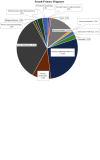Expanding the Use of Endoscopic Retrograde Cholangiopancreatography in Pediatrics: A National Database Analysis of Demographics and Complication Rates
- PMID: 36660468
- PMCID: PMC9822666
- DOI: 10.14740/gr1503
Expanding the Use of Endoscopic Retrograde Cholangiopancreatography in Pediatrics: A National Database Analysis of Demographics and Complication Rates
Abstract
Background: This study aimed to aid in risk assessment of pediatric endoscopic retrograde cholangiopancreatography (ERCP) candidates by utilizing a national pediatric database with a large sample to assess how patient characteristics may affect ERCP complication rates.
Methods: The Kids' Inpatient Database (KID) is a sample of pediatric discharges in states participating in the Healthcare Cost and Utilization Project (HCUP). This database provides demographic information, hospitalization duration, and outcome information for hospitalizations during which an ERCP occurred. International Classification of Diseases (ICD) codes were used to determine the hospitalization indication. ERCP complication rate was ascertained via ICD codes. All statistical analyses were performed using SAS 9.4.
Results: Complications were seen in 5.4% of hospitalizations with mortality observed in less than 0.2%. This analysis captured a large Hispanic population, specifically in the South and West regions. Gallbladder calculus and cholecystitis were more likely to occur in females. A higher percentage of patients in the age 10 - 17 group were female (72.2% vs. 52.7%, P < 0.01) and Hispanic (33.4% vs. 22.7%, P < 0.01) compared to the age 0 - 9 group. Age 0 - 5 and male gender were associated with lower routine home discharge rates and longer lengths of stay. Complications occurred at a higher rate in ages 0 - 5, though the difference was not statistically significant.
Conclusions: ERCP is a safe procedure for pediatric patients with low complication rates and rare mortality. We found statistically significant differences in the procedure indications between pediatric age groups, races, and genders. Age ≤ 5 years and male gender were associated with more complicated healthcare courses.
Keywords: Complication; Demographic; ERCP; Pancreatitis; Pediatric.
Copyright 2022, Lorio et al.
Conflict of interest statement
The authors declare that they have no conflict of interest.
Figures


Similar articles
-
Nationwide Evolution of Pediatric Endoscopic Retrograde Cholangiopancreatography Indications, Utilization, and Readmissions over Time.J Pediatr. 2021 May;232:159-165.e1. doi: 10.1016/j.jpeds.2020.11.019. Epub 2020 Nov 14. J Pediatr. 2021. PMID: 33197494
-
Trend and Predictors of the Utilization of Endoscopic Retrograde Cholangiopancreatography in Acute Pancreatitis Hospitalizations.Cureus. 2020 Nov 10;12(11):e11420. doi: 10.7759/cureus.11420. Cureus. 2020. PMID: 33312816 Free PMC article.
-
Assessment of the July effect in post-endoscopic retrograde cholangiopancreatography pancreatitis: Nationwide Inpatient Sample.World J Gastrointest Endosc. 2017 Jul 16;9(7):296-303. doi: 10.4253/wjge.v9.i7.296. World J Gastrointest Endosc. 2017. PMID: 28744341 Free PMC article.
-
National trends of endoscopic retrograde cholangiopancreatography utilization and outcomes in decompensated cirrhosis.Surg Endosc. 2019 Jan;33(1):169-178. doi: 10.1007/s00464-018-6290-1. Epub 2018 Jun 25. Surg Endosc. 2019. PMID: 29943059
-
Timing of endoscopic retrograde cholangiopancreatography in acute biliary pancreatitis without cholangitis: a nationwide inpatient cohort study.Ann Gastroenterol. 2021 Jul-Aug;34(4):575-581. doi: 10.20524/aog.2021.0615. Epub 2021 Feb 26. Ann Gastroenterol. 2021. PMID: 34276198 Free PMC article.
Cited by
-
Endoscopic Retrograde Cholangiopancreatography in Pediatric Population: A Decade-Long Experience from 2 Tertiary Centers.Turk J Gastroenterol. 2025 Jan 13;36(5):321-327. doi: 10.5152/tjg.2025.24462. Turk J Gastroenterol. 2025. PMID: 39840842 Free PMC article.
-
Echo-Endoscopy Combined with Virtual Reality: A Whole Perspective of Laparoscopic Common Bile Duct Exploration in Children.Children (Basel). 2023 Apr 21;10(4):760. doi: 10.3390/children10040760. Children (Basel). 2023. PMID: 37190009 Free PMC article.
References
LinkOut - more resources
Full Text Sources
